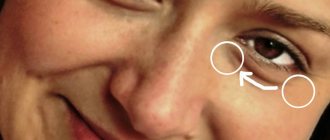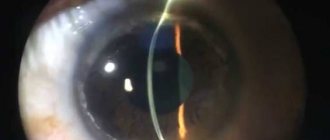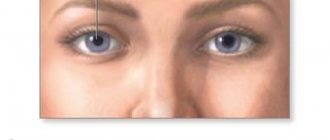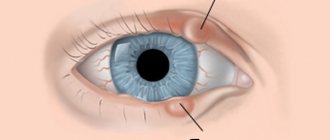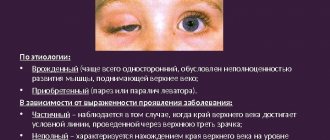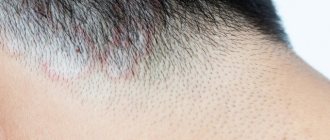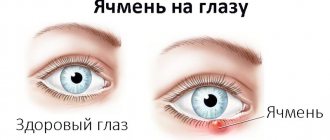Blepharitis is a whole group of ophthalmological diseases in which the eyelids and interciliary space become inflamed. The pathology affects only the outer edge, but leads to severe suppuration and affects the quality of vision and general well-being of a person. The disease quickly passes from acute to chronic, so it is useful to know the symptoms and treatment features.
Causes of blepharitis
Every third person faces various forms of this disease. The largest number of diagnosed cases occur after 35–40 years of age. It develops when a bacterial or viral infection gets into the eye, pollution, against the background of the activity of fungi, demodectic parasites. Main reasons:
- working or living in a dirty room;
- allergy;
- barley;
- anemia;
- gastrointestinal diseases;
- exposure to the sun without protective glasses;
- low-quality eye cosmetics.
Often the disease occurs in people suffering from visual impairments: when trying to see an object, they squint and strain their eyelids. The eyes get tired, irritation and dryness appear due to a lack of tear fluid. This creates an ideal environment for infection to develop.
Classification and symptoms of blepharitis
Blepharitis of the eyes begins with redness of the edges of the upper and lower eyelids, unbearable itching, and irritation. Patients note high sensitivity to light, increased lacrimation, and are unable to read, watch TV, or work at a monitor. Even at the initial stage, dandruff on the eyelashes, their active loss and growth disturbances are observed. When suppuration occurs, the whites become covered with a cloudy film that impairs vision.
Like conjunctivitis, it is provoked by the active release of inflammatory exudate. Thick mucus dries out on the eyelid, causing them to stick together. After drying, crusts remain that can get into the eye, irritate the mucous membrane and scratch the cornea. Some symptoms vary depending on the type of disease.
The most common diagnosis is simple blepharitis, which occurs after introducing dust or scratching with a dirty hand. It is characterized by noticeable swelling of the eyelids and severe redness. The patient secretes a large amount of gray pus covering the lacrimal glands. With proper treatment, it goes away quickly without complications.
When the disease worsens, an acute form occurs, which is manifested by painful symptoms and requires immediate assistance from an ophthalmologist. The severe period lasts at least 7–10 days, after which it may develop into a chronic form. When the immune system is weakened or the activity of pathogenic fungi or bacteria increases, a relapse occurs. The problem often results in the formation of a chalazion, inflammation of the eyelash follicles.
Dandruff is a real problem not only for women, but also for men. White scales that appear abundantly on the scalp completely spoil the appearance of the hair. But not everyone had to deal with another very unusual localization of this trouble. Sometimes dandruff appears on the eyebrows, which falls on the eyelashes and leaves a completely unpleasant sight. In this article we will talk about the causes and treatment of dandruff in the immediate vicinity of the eyes.
Causes of dandruff
The causes of dandruff on eyebrows and eyelashes can be both external factors and internal problems of the body:
- seborrheic dermatitis;
- metabolic disease;
- poor facial skin care, use of expired or low-quality cosmetics;
- lack of personal hygiene;
- excess of fatty, hot, spicy and sweet foods in the diet;
- demodicosis of eyebrows and eyelashes;
- fungal diseases.
It is necessary to treat dandruff on eyelashes not only because it looks unaesthetic. Firstly, it is possible to identify a fungal infection or mite that has a tendency to spread. Secondly, this is fraught with inflammatory eye diseases, since particles of keratinized skin can get into them, causing an infection. When diagnosing, it is important not to confuse dandruff with normal flaking of the skin, an allergic reaction, or acne.
How to eliminate dandruff?
The first step is to find out why dandruff appears on the eyebrows. It is advisable to consult a dermatologist to exclude the possibility of infection with fungus and demodicosis. Begin treatment by eliminating all unfavorable factors.
- Normalize your diet. Avoid foods that negatively affect your skin: oily, hot, sweet, spicy, and overly salty.
- Stop using cosmetics that are not suitable for your skin type.
- Temporarily stop using decorative cosmetics.
- Take a course of multivitamins.
If these measures do not have any effect, and the dermatologist finds signs of any disease in you, then other remedies may be recommended. Let's study them in more detail.
- If, in addition to dandruff, there is also a pronounced inflammatory process, then you can use an ointment containing glucocorticosteroids. Such products very quickly eliminate itching and relieve redness of the skin. However, despite the fact that the ointment is used strictly locally, hormones do not bring any benefit to the body. The product must be applied twice a day.
- If it is determined that dandruff on the eyebrows is the result of a fungal infection, then you need to contact a trichologist. He may prescribe you ointments with ketoconazole or other active substances.
- According to reviews from many people who have gotten rid of dandruff, one of the best remedies is sulsen paste. It has both antiseborrheic and antifungal effects. It must be used with extreme caution, no more than once a week, avoiding contact with the eyes.
Treatment in each individual case may vary significantly. Therefore, you should not start it without consulting a good dermatologist. The doctor will create an individual course of treatment for you, which will lead to results as quickly as possible.
Traditional methods against peeling eyelashes
To eliminate peeling, you can use traditional medicine. Please note that a preliminary consultation with a doctor is required, since by self-medicating, you may miss the true cause of the discomfort - a serious illness.
We have made a selection of several folk recipes for you:
- Add 0.5 teaspoon of coconut oil to the mashed banana. Spread the resulting paste evenly over the face and décolleté. You need to wear this mask for 20 minutes and then rinse with warm water.
- It is necessary to collect oregano herb and St. John's wort inflorescences, crush them and add water in the following ratio: 200 ml of water - 10 g of collection. After the mixture has been infused for two hours, it is necessary to strain it. Take 50 ml portions twice a day. Store the composition in the refrigerator.
- Squeeze the juice of fresh parsley and rub it on the irritated eyelash area.
- Pour 1 glass of hot water into 1 tablespoon of celandine. Boil the resulting mixture a little in a water bath or simply set aside to cool. Moisten cotton pads in the cooled mixture and apply lotions to the eyes, leaving them for 15 minutes.
- Cucumber water and tar soap have strong antiseptic and soothing properties. Periodic washing with them and regular wiping of the area around the eyes perfectly cope with irritation and fatigue, and are excellent means of hygiene. This method of care is especially important to use during periods of high risk of peeling: mid-spring and summer.
- Chamomile decoction has long been famous for its medicinal properties. To get rid of the active separation of dead skin flakes, you need to crush 20 g of dried chamomile, pour boiling water and let it brew for half an hour. Soak cotton pads in the cooled mixture, apply compresses to the affected areas, and leave for 20 minutes. To achieve the effect, it is necessary to carry out the procedure once a day, in advanced cases - twice a day. It is not recommended to use the infusion the next day, as it quickly loses its beneficial qualities.
- Green tea lotions also provide a noticeable calming effect. You can apply both used tea bags and cotton pads soaked in tea leaves. This compress should be applied for 15 minutes up to three times a day.
- The healing properties of aloe help get rid of flaking, itching and redness, and destroy pathogenic bacteria in the eyelash area. However, this procedure requires lengthy preparation: the cut leaves of the plant must be wrapped in cling film and placed in the refrigerator for a week. After that, they are cut into small pieces and the juice is drained. Soak cotton pads in this liquid and make a compress for half an hour. The effect will be more noticeable if the procedure is performed twice a day - morning and evening. As a rule, unpleasant symptoms completely disappear after 1-2 weeks.
Treatment with folk remedies
Folk remedies will also help to partially solve the problem or alleviate the situation. They will have an effect if dandruff appears as a result of normal flaking of the skin or the use of inappropriate products. For fungus, seborrhea and demodicosis, drug treatment is needed. Let's look at some of the most popular tips.
- Use tea tree oil by applying a small amount to your eyebrows.
- If you have dry skin, then castor and burdock oils are good options.
- Try washing your eyebrows with regular baby soap.
- Taking an internal decoction of burdock root, St. John's wort, string and aralia (about 40 ml each) will significantly speed up recovery.
In this article, you learned why dandruff appears in unexpected areas such as eyelashes and eyebrows. In conclusion, we invite you to watch a video in which a dermatocosmetologist will tell you all about the manifestations of seborrhea.
Last update: 09/12/2019
Dermatovenerologist, trichologist, candidate of medical sciences, member of the Association “National Society of Trichologists”
Having discovered a white coating on the eyelashes, similar to dandruff, people mistake it for a manifestation of seborrhea, which affects the scalp. However, scales on the eyelids, which are always accompanied by other symptoms, indicate a more serious disease. Let's look at the reasons for the appearance of so-called dandruff on eyelashes and figure out how to treat it.
Demodicosis is a disease that is provoked by the opportunistic skin mite demodex (acne gland).
The parasite, invisible to the eye, lives on the body of every person and usually does not cause any inconvenience, but under certain provoking factors (hormonal disorders, chronic conditions, immune changes, etc.) it begins to actively multiply and from a conditionally pathogenic form passes into a pathogenic one, appearing first signs of the disease.
The initial stages of demodicosis of the eyelids can be confused with blepharitis:
- crusts at the base of the eyelashes, which are mistakenly called dandruff;
- itching or burning of the eyelids, which leads to scratching and loss of eyelashes;
- sticky eyelashes;
- the edges of the eyelids are thickened, hyperemic;
- feeling of discomfort and dryness in the eyes;
- the appearance of purulent discharge;
- redness of the eyelid mucosa.
Symptoms of demodicosis most often appear in the spring and summer. If you notice such symptoms, you should consult an ophthalmologist.
In the absence of adequate treatment, demodicosis of the eyelids becomes chronic and can cause chronic blepharitis, conjunctivitis, keratoconjunctivitis, and a lipid-deficient form of dry eye syndrome.
To make a correct diagnosis, you need to submit several eyelashes for analysis (3-4 from each eyelid).
For demodicosis of the eyelids, cleansing of the surface of the eyelids and roots of eyelashes is prescribed, for example, with chamomile infusion, alcohol solution, salicylic acid, ophthalmic wipes.
It is effective to massage the eyelid, which an ophthalmologist performs with a special device to remove purulent contents and demodex, as well as physiotherapeutic procedures. After which the eyelid is treated with permethrin ointment - it must be carried out in a course. If there is damage to the conjunctiva, eye drops are also prescribed.
Doctors recommend during treatment:
- limit water and thermal procedures (saunas, baths);
- refuse to use any cosmetic products;
- follow a diet: eat more vegetables and fruits; exclude alcohol, coffee, spices, seasonings, dishes with a lot of salt or sugar; Avoid smoked, spicy, fried and fatty foods.
Diseases that can cause dandruff on eyelashes
Blepharitis
A common disease of the eyelid margins is blepharitis. It can be caused by a lack of vitamins, weakened immunity, diabetes and infections developing in the gastrointestinal tract, nasopharynx or oral cavity. Also unfavorable factors are poor hygiene, dirt, and dust in the air.
Types of blepharitis
There are several types of blepharitis, differing in symptoms.
- Scaly (seborrhea). The eyelids become red and thick, there is itching, photophobia, and narrowing of the palpebral fissure. White or yellowish scales appear on the eyelashes, at the very base. They look a lot like dandruff. Under them, the skin of the eyelids is reddish, sometimes blood vessels are visible, and the eyelids itch. Increased response to dust and wind. My eyes get very tired in the evening. Without treatment, the situation worsens and the disease becomes protracted.
- Ulcerative. Severe form, accompanied by pain. Most often appears at a young age. Scales and bleeding crusts form on the eyelids. The crusts fall off along with the eyelashes, and pus is released from the formed holes. New eyelashes begin to grow in a different direction. In some cases, scars and entropion of the eyelids form. If treatment is not started in time, inflammation will spread from the eyelids to the cornea and conjunctiva.
- Meibomiev. Characterized by inflammation of the meibomian glands. They are located in the cartilage of the eyelids. When pressed, a yellowish liquid appears, and purulent discharge appears in the corners of the eyes. Often the disease is accompanied by conjunctivitis.
- Demodectic. The cause of this blepharitis is the Demodex mite, which lives in the eyelash follicles. All people have it, but it is active only under certain conditions. Most often this is due to decreased immunity. The disease is characterized by the following symptoms: severe itching, which is especially disturbing in the morning, after sleep. The eyelids thicken and turn red. White flakes, similar to a collar or muff, form at the base of the cilia.
- Allergic. This blepharitis is often accompanied by conjunctivitis. The cause of the disease is the body’s sensitivity to medications, cosmetics or other substances. Often allergies occur due to contact with pollen, wool, dust, fluff and household chemicals. Blepharitis begins suddenly, the eyelids swell, tears flow, there is pain in the eyes, and photophobia is present. In the chronic form, the eyelids are very itchy. Exacerbation often occurs during the flowering period.
Blepharitis is also classified by location:
- anterior marginal, when only the area of cilia growth suffers;
- posterior marginal, when the meibomian glands become inflamed, which provokes inflammation of the conjunctiva and cornea;
- angular, when inflammation of the corners of the eyes is observed, occurs with purulent discharge, thickening of the eyelids and the formation of ulcers.
Eyelash mite
As already noted, eyelash mites are present on the eyelashes of every person. It does not cause harm until conditions arise that are suitable for active life of the parasite.
In the early stages, the disease is easily treatable.
Eyelash mites are a common cause of dandruff on eyelashes. It is a parasite measuring 0.5 mm. It is impossible to see him. It feeds on dead cells and secretions from the sebaceous glands.
There is no exact data on why eyelash mites suddenly begin to actively reproduce. Risk factors include lack of vitamins or other nutrients and weakened immunity. The disease can also be caused by:
- other past illnesses;
- improper or poor nutrition;
- poor hygiene;
- abuse of cosmetics;
- hormonal imbalances;
- stress and overwork;
- chronic lack of sleep;
- alcohol consumption;
- oily skin.
The tick itself is not dangerous, but its waste products are toxic and cause irritation and inflammation of the skin.
Symptoms of demodicosis are recorded not only in the eyelash area, but also in the ears, under the nose. Signs of the disease appear as:
- itching, burning;
- white coating;
- redness of the eyes;
- tearfulness;
- blurred vision;
- swelling of the eyelids, swelling.
The symptoms are especially noticeable in the morning, after sleep. It’s hard to open your eyes, there’s a crust on your eyelashes that sticks the hairs together.
Conjunctivitis
The cause of white flakes on eyelashes may be conjunctivitis. The main symptom of the disease is a sticky discharge that is difficult to remove. Pus accumulates during sleep, in the morning it dries out and becomes like flakes of dandruff.
Other symptoms of conjunctivitis:
- burning and itching, sensation of a foreign body in the eye;
- blurred vision, fog effect;
- lacrimation;
- sticky eyelashes in the morning;
- redness of the eyes;
- swelling of the eyelids.
There are different types of conjunctivitis.
- Allergic. Occurs when allergies to pathogens worsen.
- Viral, also called colds.
- Gonococcal. Caused by the microbe gonococcus.
- Diphtheric. Occurs in patients with diphtheria.
Any type of disease is accompanied by an inflammatory process. Self-medication in this case is contraindicated, because only a doctor can determine the etiology of the disease and prescribe adequate therapy. For a viral illness I prescribe antiviral drugs, for an allergic illness - antihistamines, for a bacterial illness - antibiotics. Often an additional course of multivitamins is prescribed.
Pediculosis
Dandruff on eyelashes is possible due to lice. With the appearance of parasites on the hair, a characteristic itching occurs. Particles of dead epithelium and waste products of lice fall on the eyelashes and are perceived as dandruff. You can also see the nits themselves, because they, like lice, feel great on the scalp, eyebrows and eyelashes, in the beard and mustache.
Pediculosis occurs not only on hair that lacks proper hygiene, but also on absolutely clean hair. The main route of infection is contact (from person to person, from objects, clothing, combs, bed).
It is not difficult to cure the disease; the main thing is to be systematic and follow the doctor’s advice.
Scaly blepharitis is a disease of the eyelids
Blepharitis is a chronic inflammation of the eyelids and eyelashes. The etiology of the disease can be different: allergic reactions, blockage of the sebaceous glands, infection, etc.
With blepharitis, the patient experiences:
- redness of the edge of the eyelid;
- swelling of the eyelid;
- itching of the eyelid;
- scales at the ciliary edge;
- ulceration with possible secondary infection;
- pus.
If the infection enters the conjunctival cavity, then blepharoconjunctivitis develops - inflammation of both the conjunctiva and the eyelids.
Treatment consists of eyelid hygiene. Removing scales from the edge of the eyelid with blepharitis is carried out mechanically; for this you can use blepharoshampoo, which is applied to a cotton pad and wiped over the edge of the eyelid. The next stage of treatment is the application of anti-inflammatory and antibacterial ointment. If the conjunctiva is affected, eye drops may be prescribed.
The basis of prevention is careful hygiene of the eyelids and facial skin in general.
It is very important for girls to wash off makeup before going to bed using special products, such as micellar water. Also, use only high-quality cosmetics that have not expired and are stored in proper conditions, and do not let anyone else use your mascara, eyeliner or eye shadow.
You should not rub your eyes with dirty hands - you can get an infection that will lead to the symptoms described above. For the same reason, it is necessary to monitor what pillowcases you sleep on, especially if you sleep with your face in the pillow. In addition, it is important to adhere to a healthier diet, because many diseases begin precisely because of eating errors.
Tips for caring for eyelashes
Proper eyelash care is very important to prevent dandruff.
- Wash your face twice a day. There is no need to use soap; it is better to buy foam, gel or milk.
- Carefully remove mascara, shadows and other dyes from eyelashes and eyelids. Use special products, not just washing.
- Periodically apply burdock or castor oil to your eyelashes. This activates hair growth and helps get rid of scales.
- To soften the skin and provide nutrition to the follicles, you can use lotions with string, St. John's wort, calendula, and burdock.
